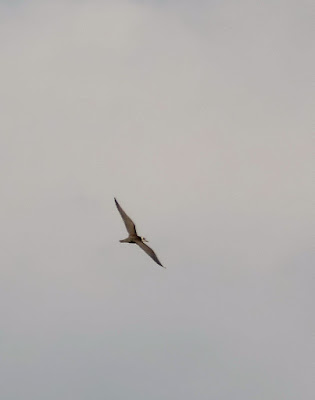We birders residing in the Delaware Valley are fortunate to live within the busy Eastern Flyway migration route. We are in easy driving distance to several migration "hotspots" and to me, the "hottest" of them all is Cape May, NJ. All the birds that migrate south through New Jersey end up sooner or later in Cape May and because of this, the quantity and diversity of birds found hear can be mind-blowing.
On Tuesday, October 11, 2016 I went birding at Cape May. A nice cold front had come through two days prior and as a rule the second day after the front is usually the best for migrants. The strong winds have usually subsided and birds are on the move.
I birded only three areas, spending the majority of time on the Higbee Beach Dike and walking around the Northwood Center. I made a quick stop at the Magnesite Plant hoping to find newly arrived sparrows.
 |
| Areas Birded - Higbee Dike, Magnesite Plant and Northwood Center. |
Higbee Dike is an outstanding spot to watch migration, but it isn't for everyone. On a good flight day, the birding can be fast and furious. I would guess that 98% of the birds seen here are in flight only and of these, maybe 75% can be identified to species. If you are wanting nice, prolonged looks at birds, this is not the place, but, if you want an identification challenge and a chance to capture some unique flight images, then this is the place. This is frenetic birding that should be experienced by everyone at least once. The Cape May - Morning Flight Songbird Count is conducted here each fall August - October.
Some of images from the dike.
 |
This young Bald Eagle passed by soon after sunrise providing some nice photo ops.
|
There were a number of American Robins heading south.
This local Belted Kingfisher was busy searching for breakfast.
October is usually considered the end to the warbler migration with diversity and quantity decreasing through the month, but it is also the peak time for Yellow-rumped and Palm Warblers. Both were evident today. At times, flocks of 20-30 Yellow-rumps would be in view. A few other warbler species were also seen but in much smaller numbers.
These are a few of the Yellow-rumped Warblers that came by.
These are some of the other warblers that were migrating today.
Northern Parulas
Black-throated Blue Warbler
Black-throated Green Warbler
Cape May Warbler
Palm Warbler
October also ushers in the peak of the Northern Flicker migration and today was no exception.
Northern (Yellow-shafted) Flickers
It appears this fall that we are in the midst of an incursion of Red-breasted Nuthatches and possibly Purple Finches, as sightings of these birds have been increasing weekly. Both species were seen today heading south.
Red-breasted Nuthatches
Purple Finches
Scattered within the flocks of Purple Finches were several House Finches.

House Finches
A species that I was a little surprised to see migrating along the bay was Eastern Meadowlark. The dike was entertained by a few fly-bys.
 Eastern Meadowlarks
Eastern Meadowlarks
Of course, all this songbird activity attracts numerous raptors that are also heading south especially accipiters.
 Sharp-shinned Hawk was the most numerous raptor today.
Sharp-shinned Hawk was the most numerous raptor today.
A few other raptors were also cruising by.
Merlin
Northern Harriers
Birding at the Magnesite Plant produced Chipping, Song, Savannah and Swamp Sparrows along with more Yellow-rumps but not much else.
Birding at the Cape May Bird Observatory's Northwood Center is much more relaxed even when the trees and bushes contain numerous birds. Here, the birds will be feeding on berries or insects, perched for a bit nearby or flitting from one nearby tree to another.
Here are some images taken at the Northwood Center.
Cape May Warbler
Golden-crowned Kinglets
Red-eyed Vireo
 Yellow-rumped Warblers
Yellow-rumped Warblers
Here are my eBird Checklists for this outing.
Higbee Dike http://ebird.org/ebird/view/checklist/S32026912
Northwood Center http://ebird.org/ebird/view/checklist/S32027132
The official Morning Flight Count for this day can be found here
http://trektellen.org/count/view/1746/20161011.






































































